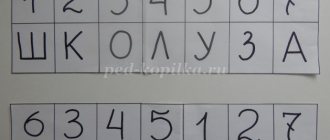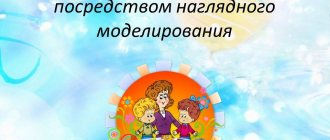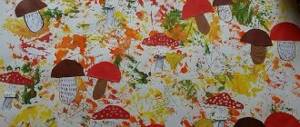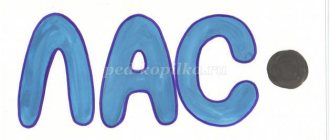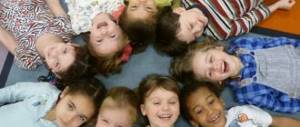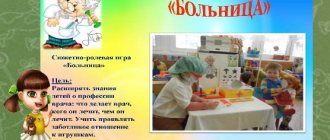Summary of a lesson on the development of coherent speech in the preparatory group
Target:
practice differentiating clothing by season (summer, autumn, winter, spring), by purpose (holiday, work, sports), by accessory (men's, women's, children's); continue to develop the ability to correctly write a descriptive story about clothing; fix the names of the professions of people who make clothes (fashion designer, fabric artist, cutter, seamstress); development of mental processes: attention, memory, imagination. Development of fine motor skills. Cultivate a caring attitude towards clothing.
Preliminary work.
Conversation on the topic of clothing. Examination of fabrics (jeans, synthetics, chintz, fur, drape) from which clothes are made. Looking at illustrations. Solving riddles, learning tongue twisters. A role-playing game was carried out in the “Clothing” and “Atelier” stores.
Org. moment.
The children are in the waiting room.
- Today we will go to an unusual and very fascinating world, a world in which fashionable and very beautiful clothes are created.
- Do you want to go there? I invite you to a lesson.
Progress of the lesson.
The teacher asks the children who the fashion designer is and how his ideas are translated into reality.
— Guys, do you know who a fashion designer is?
— Guys, do you know how fashionable and beautiful clothes appear?
- You want to know?
“Then we’re off on an exciting journey.” Guys, look where we ended up?
- Notice who it is?
- What is she doing?
- Certainly. A seamstress sews beautiful, fashionable clothes according to a designer's sketch. Look at how many different tools, threads, fabrics, and accessories she has.
The teacher invites the children to imitate the sound of a typewriter,
- Guys, let’s try to imitate how a typewriter knocks, knocking your teeth; how scissors cut (articulation gymnastics “watch”); Let's draw a needle.
The teacher draws attention to the mannequin standing nearby.
- Well done guys, what do you think this is?
- That's right, a mannequin and a ready-made dress on it. Guys, what is it like? Let's touch it and tell you what it feels like.
— At every time of the year we wear clothes appropriate to the season. A seamstress sews clothes for different seasons. Which one? (summer-summer clothes, autumn-autumn clothes, winter-winter clothes, spring-spring clothes).
The teacher asks the children the name of the clothes that we wear in summer, autumn, winter, spring.
The teacher differentiates clothes according to their affiliation (men's, women's, children's).
— Guys, do people in this profession sew clothes only for adults?
(children's answers)
Show slide show.
Children transform words into diminutive forms.
first slide the adult model is wearing a skirt - the girls are wearing a skirt;
on the second slide there is an adult model in a dress - a girl in a dress;
on the third slide, adult models are dressed in shorts - young models are in shorts;
on the fourth slide, the adult model is wearing a raincoat - the young model is also wearing a raincoat;
on the fifth slide the adult model is wearing a scarf and a hat - the boy is wearing a scarf and a hat.
The teacher pays attention to the dim light, the sound of music, the podium, and the fashion show of models.
- Guys, do you hear the music playing, where do you think we ended up?
The teacher invites the children to go and sit on the chairs.
- Please come in and sit down. Good afternoon, we are glad to see you at the show of the 2012 summer clothing collection. In the new year 2012, all colors and shades will be relevant. We greet the first model Zuuru with thunderous applause.
The teacher asks the children about the model, its purpose, seasonality, color scheme, texture, and fabric properties.
— Guys, look at our model in a beautiful dress. What kind of dress is it? What color scheme? What decorative elements is the dress decorated with? What season do you think this dress would be suitable for?
- Thank you, and we are meeting the second model. Guys, let's describe this wonderful outfit.
The teacher seeks a complete description of the clothes that the model is wearing.
The teacher thanks the models for the wonderful fashion show and the guests (children) for their active participation in the discussion of the models.
— Thank you to everyone for your active participation in the show of the summer collection.
The teacher invites the children to play the role of fashion designers and create their own sketch of clothes.
— Today you and I learned and saw a lot of new things. We visited the workshop and a fashion show. Do you want to be a fashion designer?
“But in order for our sketches to turn out beautiful, our fingers need to rest.” Get your fingers ready.
Finger gymnastics.
Alenka - Malenka (Clap of palms)
Nimble, fast: (Hit your fists against each other 2 times)
Apply water (Bend your fingers one at a time, starting with the thumb)
I finished the sundress,
Knitted a sock
I picked berries
Finished the song
It ripened everywhere. (Clap hands)
She cares about hunting. (Hit your fists against each other 2 times)
“Our fingers have rested, our heads have come up with a sketch of clothes, take your chairs and go to the fashion designers’ workshop.” Look on the tables there are a lot of different clothes, colored pencils, choose the clothes you like, sit down at the tables and transfer your imagination to a piece of paper. You can start.
The teacher approaches each child and is interested in the design that will be on his clothes.
After completing the work, the teacher suggests putting all the sketches in an envelope and sending them by mail to the famous fashion designer Vyacheslav Zaitsev.
— Well done, everyone managed to make their dreams come true. Now let's put all the sketches in an envelope and send them to the famous fashion designer Vyacheslav Zaitsev. He will probably be interested in the clothes of the children of the preparatory group of kindergarten No. 103. And we will very closely follow the latest fashion news and wait for the presentation of our clothing collection.
At the end of the lesson, a summary is made.
- What did you and I do in class? Where have we been today? What kind of clothes were we talking about, why do we need them? What did you like?
The teacher thanks the children for their activity in class. Everyone was very attentive and tried to answer questions correctly.
Offers to return back to the group.
